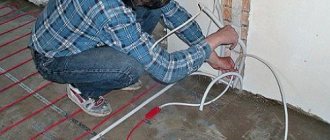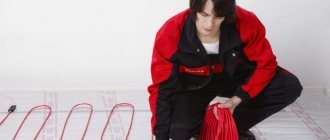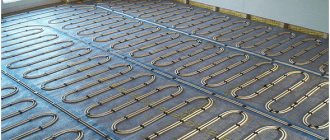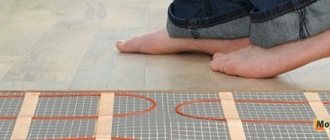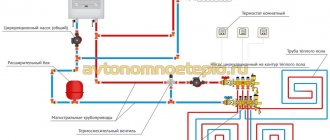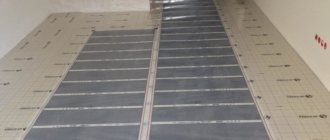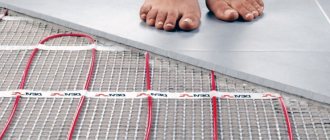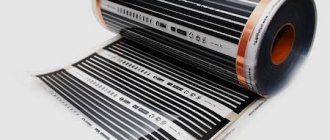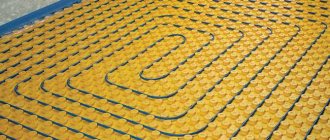A heated floor will help ensure adequate heating of rooms, especially in a private home. However, it is not always possible to install electric heating, and people often opt for a water heating system. At the same time, if there is no option to connect it to a centralized heating system, it is necessary to install an electric boiler for heated floors . How to choose an electric boiler? How to install it yourself? We will talk about this in our article.
Electric boiler for heated floors
Scheme of proper installation of a warm water floor
There is one rule for all pipe laying schemes - installation of pipes must begin from the walls and move towards the center of the room, and then lead the pipes to the exit of the room. The layout of heating pipes is very important for saving heat.
The advantage of a snake is its ease of installation. The pipe is laid, sequentially moving in a zigzag from one wall to the opposite
Laying schemes:
- Snake;
- Snail;
- Combined installation.
It is necessary to consider all 3 heating installation schemes. Snake - pipes run along the perimeter of the room near the walls, and then from one of the walls (this will most likely be an internal, warmer wall) returns back in a wave.
Snail - pipes follow the perimeter of the room and each circle narrows, approaching the center. This scheme will be especially applicable for rooms with 2 external walls (corner room) or a room located on the north or east side. The combined scheme combines both the first and second schemes. But in any case, it is necessary to make a detailed drawing of the layout of the pipes in the room.
Prefabricated manifold systems
A complete manifold system, along with shut-off valves and temperature regulators, includes:
- mixing unit;
- drain tap;
- air exhaust;
- a pump that circulates liquid in pipes.
An analogue to a shut-off valve at the inputs/outputs can easily be a valve with a control thermostat. The main advantage of these devices is their ability to contract and expand depending on the set optimal temperature, setting the intensity of the flow of heated liquid.
The mixer pump must be installed between the supply clamp and the supply pipe, while the third outlet goes to the return and is located in front of the return clamp. The resulting connection will allow the pump to take cooled liquid from the system and transfer it directly to the supply.
Homemade on heating elements or factory
If desired, purchase a factory-made electric boiler. However, it is worth understanding that a homemade design will be cheaper with the same efficiency; various control variations can be connected to a homemade boiler, and the piping can be supplemented with new components. This feature will not be available in a finished factory product.
Photo 1. Single-circuit electric wall-mounted boiler, model EVPM-Next, , Russia.
A properly functioning electric boiler optimally copes with heating the house and prevents power failures on the batteries.
The design and implementation of complex and obscure connection schemes is carried out under the supervision of experienced specialists.
The liquid in the boiler does not boil, heating is uniform and constant. Preference is given to low-temperature systems - they are safer and more controllable. If there are temperature fluctuations, replace the heater and regulator.
Which boilers can be combined with heated floors?
The best boiler option for heating floors is an electric boiler. Moreover, regardless of whether it is a heating element, induction or electrode. It has optimal efficiency even when operating at low power. In a small house, such equipment can be connected directly to the floor heating system. In large rooms it is better to make the connection using a special distribution and mixing unit.
The boiler operates automatically and requires virtually no human control. It is easy to install and easy to maintain.
Autonomous circulation group Isoterm Watts 44.02.070
You can also use condensing gas boilers, which can operate efficiently with a slight heating of the coolant. But conventional gas units require the installation of a mixing unit, which will have control elements. This is an excellent option for combining radiator heating and a heated floor system.
Solid fuel and liquid fuel boilers are not the best option, although they can also be used to organize a floor heating system. They require the installation of a mixing unit with thermometers, controllers and other additional equipment. Yes, and it is very difficult to adjust the desired temperature with their help - sometimes they produce too hot a coolant, sometimes too cold.
Principles of technology for connecting a heated floor to a heating system
System and stages of installation of a warm water floor
The technology for concrete screed is the simplest. The first thing to do is to clean the floor of old floor coverings and cement all cracks and potholes.
Any work begins with drawing up a plan and preparing the workplace
Thermal water floor installation system:
- Cleaning and leveling the subfloor;
- Waterproofing;
- Installation of edge insulation around the perimeter of the room;
- Thermal insulation;
- Reinforcement;
- Installation of heating pipes;
- Connecting heating pipes to the boiler;
- Trial;
- Pouring the floor with concrete or cement screed;
- Break – 1 month;
- Sound insulation device;
- Decorative flooring.
It is also necessary to check the floor level; if the difference is up to 1 cm, then you can ignore it, but if the difference is more than 2 cm, then you need to level the floor with a cement screed and allow the surface to dry for at least 2 weeks. Next, you need to waterproof the floor in case of hot water leakage from the pipes
Along the perimeter of the room, apply edge insulation with damper tape to the height of the proposed floor. Thermal insulation is the next stage of action. The insulation must be laid throughout the room; the minimum thickness of the insulation is about 2–5 cm. Next, reinforcement should be carried out over the entire surface of the room. To do this, you need a purchased reinforcing mesh with cells of 16–21 cm. It is to this mesh that the heating pipes will be attached, because they bend perfectly. The pipe routing is secured using special plastic ties or clips (track).
Emergency strapping options
Whichever heating system option you choose, dual-circuit heating systems must have an emergency circuit that will act as protection in the event of various unusual situations, for example, if the electricity is suddenly cut off. There are several ways to cope with this problem.
Boiler emergency piping diagram
The supply of water from the water supply system to the system is used quite rarely, as it is ineffective. The whole point is that the plumbing system stops working when the power goes out. A certain amount of water is stored in hydraulic accumulators, however, this amount will simply not be enough to prevent overheating of the equipment. If antifreeze is used as a coolant, then approximately 150 liters of this expensive substance will simply be drained into the sewer system.
If you connect the circulation pump to an uninterrupted power source, you can be safe from a power outage in the network. However, this solution also has its drawbacks. This power supply may not work due to some unexpected situations. In addition, boilers with a double-circuit system require constant maintenance and preventive maintenance. It is constantly necessary to monitor the health of the batteries and check for serviceability by charging and testing their performance.
The circuit protects the heating system from overheating
The concept of gravitational circulation refers to a special circuit, which is characterized by small dimensions and serves to remove excess thermal energy in the heating system. This circuit must be turned on only after the pump is turned off, which will lead to the fact that not the entire building, but some part of it, will be heated.
One of the most effective methods is to create an emergency circuit. It is an indispensable component of any good heating system. Thanks to this circuit, the gravity and forced circuits can function in different parts of the system as usual. However, when the pump is turned off, only the gravity circuit will work.
So, we have discussed the main functions and technical characteristics of existing electrical boiler piping schemes. You only need to make your choice, relying on your technical knowledge, family budget and the general design of the heating system in your home. Having weighed all the nuances and settled on the scheme that is ideal for your home, you should proceed directly to installation.
Characteristics
The parameters of electric boilers reflect their ability to operate in systems of a certain size and capacity.
Typically the following characteristics are indicated :
- heater type;
- heater power;
- power consumption;
- electricity consumption;
- heat exchanger volume;
- volume of heated space.
In practice, power and volume are of decisive importance; other qualities are essentially derivatives of these quantities.
Electric and solid fuel
There are several types of boiler equipment, differing primarily in the type of fuel used. The most popular are:
- Electric.
- Solid fuel (pellet) boiler.
- Gas equipment.
Pellet
Despite the fact that in recent years there has been almost universal gasification, gas-powered equipment is still rarely installed in rural areas. Its main area of application is city apartments and country cottages, which are close in terms of living comfort to the conditions of a metropolis. In villages, solid fuel equipment is more often installed - a wood, pellet or coal boiler.
The most important advantage that distinguishes a solid fuel (pellet or wood) heating boiler is its low cost and ease of operation. In rural areas, firewood remains the cheapest fuel to this day, and the likelihood of supplying gas to remote corners of the country is still almost a fantasy.
Electric
An electric heating boiler has a lot of advantages, but all of them are covered by one significant disadvantage - high operating cost. In some ways, the following can also be considered disadvantages of the equipment:
- Volatility of the system. A power outage will have negative consequences for the entire heating network, and not just for the device itself. To minimize the risk of the system defrosting in the event of a power outage, an additional emergency generator will be required.
- The electrical network must be able to withstand significantly increased load. An additional line may be required. You will definitely need to install a separate machine.
- The device must be connected by a qualified electrician. Unprofessional installation is life-threatening.
According to the principle of operation, electrode and heating element electric boilers are distinguished. We will not dwell on the former, since it is extremely difficult to design and install such a device. Let's take a closer look at heating elements devices.
Induction electric boiler
Having appeared relatively recently, boilers of this type have already gained enormous popularity. The principle of their operation is quite simple: a functioning device generates electromagnetic waves that interact only with metal. They do not affect other materials in any way, therefore, even with direct contact with the boiler, it is impossible to get burned.
An induction boiler consists of two main elements:
Emitter
- emitter;
- a pipeline with circulating liquid that receives radiation.
The pipeline (another name is the receiver) has quite large dimensions, therefore, if plaque forms on its internal walls, this will not affect the efficiency of work soon.
Pipeline (another name is receiver)
Advantages of induction boilers
Among the positive qualities of this device it is worth highlighting:
- reliability;
- safety;
- possibility of using any type of coolant;
- protection against plaque;
- Constantly high efficiency;
- quick access to working mode;
- no detachable connections.
Making an induction boiler
Induction heating boilers
The design of these boilers, just like heating elements, is quite simple, so if you wish, you can do it yourself. You just need to prepare:
- welding inverter;
- wire cutters;
- grinder;
- steel wire;
- stainless steel wire rod;
- plastic pipe with thick walls;
- adapters;
- metal mesh;
- enameled copper wire.
Stage 1. The material that will be irradiated with electromagnetic waves will be small pieces of wire rod or steel wire ø7 mm. The maximum length of the segments is 5 cm.
Stage 2. You need to make the case. It will simultaneously:
- the basis for creating an induction coil;
- part of the heating main.
To make the body, a plastic pipe with an internal diameter of slightly less than 5 cm is used.
Stage 3. Adapters are used to connect the boiler to the water supply. Through these adapters, cooled coolant will flow into the boiler, and heated coolant will go back into the pipeline. At this stage, the first adapter is attached to the base.
Stage 4. An iron mesh is laid at the bottom of the structure. It will prevent pieces of wire from getting into the line.
Stage 5. After this, the wire itself is filled in. There should be just enough to completely fill all the free space of the container. The upper part of the housing is closed with a second adapter.
Stage 6. After creation, you can proceed to the main thing - the induction coil. Enameled copper wire is taken and wound around the body in ninety turns. They should be placed approximately in the center of the structure.
Step 7. Then the electric heating boiler should be connected to the heating system. To do this, a small section is cut out of the pipeline, and a structure is attached in its place.
Stage 8. The coil is connected to the inverter, the system is filled with water.
The main stages of work on creating a boiler
There is a certain sequence of work that is recommended to be followed when manufacturing an electric boiler:
- Create a diagram of the general operation of the system. Here a special single-circuit heating circuit can be used, or in extreme cases a double-circuit one.
1 - heated water outlet pipe; 2 - reservoir; 3 - heating element; 4 - cold water inlet pipe; 5 - upper flange with sealing gasket; 6 - pallet; 7 - bottom flange; 8 — pan cover; 9 — bottom of the tank (base of the heating element); 10 - hole for power cord; 11 - gasket
It is important to ground and subsequently install the boiler to eliminate static electricity. It is necessary to ensure the circulation of the liquid by means of its heating temperature. It is necessary to prepare effective materials for radiators that interact ideally with water.
After this, you can proceed to the technological process. Using a conventional welding machine, a small container is attached to one end of the pipe. An electrode is built into the back side, which must reach the bottom. After this, the pipe is welded on both sides.
Important! Before welding, it is recommended to pour approximately 0.7 liters of water, only then mount the electrode. . The pipe is fixed in the wall surface with a slight slope, after which grounding is done
After this, a phase is supplied to the housing. The next step is to turn on the normal voltage of 220 W. The power of this device will be regulated using a pressure gauge, which must be connected through a special three-way valve.
The pipe is fixed in the wall surface with a slight slope, after which grounding is done. After this, a phase is supplied to the housing. The next step is to turn on the normal voltage of 220 W. The power of this device will be regulated using a pressure gauge, which must be connected through a special three-way valve.
The resulting boiler will heat up to a temperature of 120 degrees. At the same time, the level of closedness of the system completely eliminates the formation of corrosion in the internal part of the pipe. This significantly increases the total operating time of the device; moreover, you may not be able to control the overall composition of the liquid.
Consultation on choosing an electric boiler for heated floors
Heating systems based on warm water floors are used in homes, offices, and commercial real estate. For heating, electric boilers are often used, which are characterized by their compact size, affordable price, and high degree of automation. By installing a GSM thermostat for a boiler of this type, you can control the heating system using a smartphone. All this, along with a wide range of equipment, attracts potential customers. Many domestic and foreign manufacturers produce electric boilers. Are there any particularities in choosing equipment for a heated floor system and which model should you choose?
Basic requirements for boilers
The water temperature in heating radiators can exceed +70ºС; such parameters are not relevant for heated floors. If you heat the heated floor to such parameters, then it will be impossible to walk on it barefoot, and the living room will turn into a sauna. The maximum temperature of the water leaving the electric boiler should not exceed +55ºС. In this case, the floor temperature will be slightly below +30ºС, which will ensure the maximum level of comfort in the house. Accordingly, electric boilers that are planned to be used in a heated floor system must be equipped with temperature control systems in the region of the specified limit. For most models with heating elements, this possibility exists, but for electrode-type boilers, the minimum coolant temperature does not fall below +60ºС. If such equipment has already been purchased, then you need to take care of the cold water mixing unit.
Additional criteria for choosing a boiler for heated floors
Other parameters for choosing heating equipment are similar to those that have to be analyzed for equipment used in a traditional heating system. This does not make them any less important; they must be taken into account. The property owner will need to decide on the following characteristics:
- power;
- type of installation;
- number of circuits;
- availability of automated security systems;
- functionality.
The boiler power must be sufficient to heat a room of a certain area. For a cottage of 300 sq.m. Heating equipment with a power of at least 30 kW is required. It can be wall-mounted or floor-mounted - the type is selected based on the available space in the house and the weight of the equipment. Powerful boilers are heavy and mounting them on the wall is not advisable.
You can use both a double-circuit and a single-circuit boiler for a heated floor system. The presence of automatic systems that monitor safety is mandatory. You can neglect the automation of the control system, since the GSM thermostat is in some cases more functional. It allows you to control heating via your phone, which saves energy as much as possible and provides a high level of comfort.
Some manufacturers offer electric boilers that are functionally designed for heated floors. Such models do not require additional equipment for connection, which makes installation less expensive. If the boilers are not functionally designed for heated floors, then most likely you will need a comb, temperature sensors and a mixing unit. This equipment will allow you to supply coolant with an optimal heating temperature to the system.
One of the main problems of owners of electric boilers is reducing energy costs. They can be minimized by installing automation that operates through sensors installed at a height of 15-20 cm from the floor.
They reduce the heating level and maintain a comfortable temperature. An alternative to them would be a GSM thermometer, which allows you to control the temperature of the coolant and maintain it at a minimum when there are no inhabitants in the house. You can ensure a comfortable temperature with one SMS message shortly before returning to the owners’ home.
Which brand is the best
An important factor when choosing a boiler will be the brand under which the equipment is manufactured. There are quite a few manufacturers that supply heating boilers to the market. Let's get acquainted with the main and most popular of them, as well as the brands of boilers and their costs. The emphasis will be on electric boilers, since they are the best option.
Buderus Logamax, E series
Country of origin: Germany. These are new heating element wall-mounted boilers of various capacities. Eco-friendly heat sources that are used to heat premises for various purposes, including residential ones.
Buderus Logamax, E series
pros
- it is possible to connect to any heating system;
- mounted in closed systems;
- high efficiency;
- The models are easy to install and require a minimum number of additional elements.
Minuses
high price.
buderus e213
Kospel EKCO
Country of origin: Poland. These are heating element boilers, which are designed taking into account the connection of a heated floor system. Installed on walls, they allow you to smoothly regulate the power of the equipment. Allows you to configure automatic switching on. The temperature can be adjusted from +30 to +85 degrees.
Kospel EKCO
pros
- there is a 6-step power adjustment, which has a positive effect on energy consumption;
- ease of installation and use;
- high efficiency.
Minuses
high price.
Kospel EKCO
“Galan”, series “Hearth”, “Geyser” and “Vulcan”
Country of origin: Russia. Electrode boilers are quite reliable and economical compared to any heating element units. They pay for themselves quickly and can be optimized for different levels of heat loss. Service life is about 30 years. This is a flow-type equipment and therefore does not require approval from regulatory authorities. Heating of the coolant occurs due to its ionization; heating is carried out without a heating element. The equipment is automated, which allows you to set the required temperature and not monitor it.
“Galan”, series “Hearth”, “Geyser” and “Vulcan”
pros
- affordable price;
- ease of installation;
- silent operation;
- dimensions.
Minuses
- fear of voltage surges;
- heavy load on electrical wiring.
galan hearth
Ferroli
Country of origin: Italy. Wall-mounted electric single-circuit boiler. Connection to a single-phase or three-phase network. Built-in weather-compensating automation and boiler heating function. Digital control and self-diagnosis system, control panel with large LCD display, built-in weekly programmer. It is possible to connect an external storage tank for the production of hot water and a low-temperature circuit (warm floor).
Ferroli electric boiler
pros
- wide range of different capacities;
- good quality of components;
- large informative LCD display;
- the possibility of using non-freezing liquid in the heating system.
Minuses
- high price;
- Chinese assembly;
- Lack of room thermostat included.
Ferroli zews electric boiler
RusNIT
Country of origin: Russia. Compact and lightweight electric boiler for wall mounting. Can be used as a main or backup heating device for residential buildings, cottages, and various domestic premises with an area of up to 80 m².
Electric boiler RusNIT
pros
- affordable price;
- withstands low voltage;
- connection to single-phase and three-phase networks.
Minuses
Connection difficulties may occur.
Rusnit 209m
Advantages and scope of electric boilers
Most often, electric boilers are used in dachas and private homes. This is due to the fact that this equipment has a low cost and at the same time you can install it yourself, without calling a specialist.
Among the main advantages of electric boilers are:
- the equipment is safe (the design does not include open flames or the presence of flammable fuel sources);
- water heaters can be switched off for up to six months, without harm to their performance (relevant for dachas and country houses that are rarely visited);
- the dimensions are relatively small, so it can be placed in any room;
- Today there is a huge variety of electric boilers, varying in power, installation method and principle of operation;
- When water is heated, soot does not appear, which is dangerous for both humans and the environment.
Safety requirements
The safety requirements for electric boilers are general and apply to installations of this type.
Required :
- the presence of insulated supply cables having the required cross-section;
- The cable is laid in the appropriate cable channel;
- Protective grounding is required.
Important! Installation and connection of the device must be carried out carefully, without any exposed cable sections or exposed wires. It is necessary to monitor the condition of the heat exchanger body to prevent phase breakdown to the coolant (usually such protection is provided for by the boiler design, but safety is paramount).
Types of equipment
The larger the area of the water circuit, the more powerful the heating unit should be
When choosing heating equipment, first of all you need to pay attention to such characteristics as:
- number of circuits;
- heating features;
- installation method.
Electric boilers for heated water floors can be installed on the floor or fixed to the wall. The floor-standing heating element device is distinguished by its significant weight. It is equipped with a boiler, the internal structure of which includes not only an insulated container, but also a tubular heater.
Dual-circuit appliances allow you to separately heat water for domestic needs
Among the boiler equipment models on the market, the most popular are two types of devices:
- single-circuit;
- double-circuit.
Both heating elements and electrode electric boilers can be single-circuit. Both of them carry out activities aimed at heating the liquid, which acts as a heat carrier. Double-circuit heaters also heat the coolant - water for hot water supply. For this purpose, exclusively heating elements are used.
The installation of this equipment is justified by the fact that it is possible to use a two-tariff meter.
This means that the liquid is heated at night, and heated floors are heated during the day.
Speaking about the heating principle, it is worth mentioning the convenience of electric heating elements. Their main distinguishing feature is a wide power range, which is easy to adjust.
Device
The design of electric boilers largely depends on the type of design, so you should consider them in order:
- Boilers with heating elements as a heater. The heat exchanger, inside of which there is a heating element, when turned on, it begins to heat the water. In essence, the principle of a conventional boiler is used. The system is simple and most vulnerable from the point of view of many processes that destroy and weaken the functionality. With a high efficiency of the heating element, equal to almost 100%, over time, scale will inevitably form on it, which significantly reduces heat transfer. The service life of the heating element, declared by the manufacturers, is 10 thousand hours, which in itself is not very long, but in practice, not every heater reaches this value - the coil burns out. Heating elements cannot be repaired.
- An electrode boiler works on the principle of heating water between two electrodes under voltage. There is a container - a heat exchanger, inside which an electric current is passed through the water column from one contact to another. There is a saving of about 40% of energy, since there is no need to heat anything - the temperature of the water changes depending on the course of the physical process. The inconvenience is that only special compounds can be used as a coolant, which eliminates the possibility of heating household water.
- The induction type of heater is the most advanced and economical of all currently used types of electric boilers. There is an inductor. It plays the role of the primary winding. Secondary (like a short-circuited turn) - heat exchanger housing. When current is passed through the primary winding, the secondary winding is inducted, causing it to heat up and give off heat to the water inside. Since the heating area is maximum, the boiler’s operating efficiency is very high.
Types of boilers for water floor heating
There are several types of boilers for heating the coolant, that is, water. They differ in the features of operation, installation and operation, as well as the type of fuel on which they operate.
Heating boilers
Table. Types of heating boilers.
| Type | general information |
| Single-circuit | Such boilers heat only the coolant (in our case, water). In order for them to be used for anything else, boilers, heat exchangers, etc. must be purchased. |
| Dual-circuit | Boilers of this type can be used to heat water and for heating purposes. Heating in such a unit is possible due to the presence of a heat exchanger or boiler directly in the device itself. |
Boilers can also be divided into two categories based on their installation location. They are wall-mounted and floor-mounted. Floor-standing ones, as a rule, have more power than suspended ones. But the latter are much more convenient to install and less expensive to maintain.
Installation of a BAXI gas boiler + Protherm electric boiler
Diesel boilers
In this case, the fuel is ordinary diesel fuel. These units are productive and very efficient, they are completely autonomous, that is, they do not depend on whether they are connected to any communications (gas, electric networks, etc.). They are easy to install, easy to operate and have high efficiency rates with low fuel consumption.
Diesel boiler design
diesel heating boilers
Solid fuel boilers
The fuel for these units is firewood and fuel pellets. The operating principle is similar to burning wood in a conventional stove. But in this case, combustion occurs at high temperatures (from +250 degrees) and without air access. Heating of the coolant occurs due to the release of hot smoke during fuel combustion.
Solid fuel boiler for heated floors
Such boilers are rarely used in residential premises; their usual areas of use are manufacturing and agriculture. These units in the house require constant attention, as well as fuel loading, which complicates operation.
Solid fuel boiler diagram
solid fuel heating boilers
Gas boilers
It is not difficult to guess that this type of boiler runs on gas. The body of these devices is usually made of cast iron or steel, which will determine the service life and ease of installation. Steel boilers are much lighter than cast iron, they are small in size and easy to repair. However, their service life is shorter. This is why cast iron units are more expensive, as they are characterized by increased reliability. The devices can operate on both main gas and liquefied gas from cylinders. They are quite economical, and for heating only floors you can use a low-power unit.
Gas boiler for heated floors
These boilers are not recommended for connection to a heated floor system. The reason is simple - they, of course, are able to maintain the water temperature at low levels (about +45 degrees), but in fact they are designed to heat the coolant at least +80 degrees. Because of this, the efficiency of the boiler will drop greatly (up to 15%).
But there is still the option of using a gas boiler to work with a heated floor system. To do this, you will have to use a mixing unit equipped with a special distributor and a circulation pump. However, this will also increase the costs of purchasing equipment and its installation.
Gas floor-mounted double-circuit boiler
gas heating boilers
Electric boilers
These electrically powered units can be used in any application and are best suited for connection to an underfloor heating system. Connecting this boiler is simple, despite its apparent complexity. Such units will allow you to organize low-temperature heating - the kind that is needed for heated floors - due to the ability to adjust the temperature of the outgoing coolant flow.
Diagram of an electric boiler for a warm water floor
In the photo - an electric heating boiler
electric heating boilers
Heating cost
For now, the cheapest type of heating is gas.
But the situation may soon change: it is rapidly becoming more expensive. In the meantime, when installing a gas boiler for a warm water floor, you will pay the least for the energy used monthly. Second place goes to fuels that are unusual for our country - pellets and fuel briquettes. If we compare the cost of a ton of firewood and pellets, then pellets are more expensive, but in terms of the cost of a kilowatt of heat, the use of pellets/briquettes is cheaper. These small granules are produced from waste from the wood processing industry or crop production. At the same time, their calorific value is higher than that of the best firewood, and for the highest quality pellets it is even comparable to the amount of heat generated by some brands of coal. And at the same time there is ten times less waste (ash). Fuel briquettes can also be included in this category. It’s just that pellets are usually used in special installations, and briquettes can be used to heat ordinary solid fuel boilers.
Pellets and fuel briquettes are not yet widely used in our country, but heating with them is economical. We are also pleased with the high degree of autonomy of operation of units using this fuel.
The third and fourth places are contested by firewood and coal. In some regions it is more profitable to heat with wood, in others - with coal.
Fifth place for liquid fuel - it's not cheap. Operating costs also include the need to heat the fuel tank, or install the tank in a heated room. In addition, installations using diesel fuel require a boiler room. Moreover, it is better to build a boiler room at a decent distance from the house: the noise during operation of the burner is decent, and the smell is strong, and it penetrates everywhere.
It is generally accepted that the most expensive heating is electricity. But when using automated modern devices you have to pay only a little more than when using coal or firewood. So don’t discount electric boilers for heated floors. It’s just that for more economical heating, it is advisable for you to take a heating unit with the ability to adjust the power. In some traditional electric boilers, heating elements are assembled in groups, and automation, turning the groups on/off, regulates the operating power and saves energy. For heated floors, it is advisable to take a three-stage, or, in extreme cases, a two-stage unit. Induction and electrode boilers themselves are economical (if controlled electronically) and have low inertia, that is, they do not waste energy.
Heating cost depending on the type of fuel used
Installing the unit
First you need to install an electric boiler indoors. As we have already said, the unit can be floor-mounted or wall-mounted. In the first case, the kit includes a special stand, on which the “landing” is performed.
In order to hang the boiler on the wall, you need to prepare anchors with dowels and a drill with a suitable drill bit. First, mark the wall using a tape measure and a marker.
The holes must be placed perfectly level in a horizontal plane. Next, we drill out the marked places, drive dowels into them and screw in the anchors. After the anchor is firmly seated inside the wall, you can hang the electric boiler.
We draw your attention to the fact that the installation of the electric boiler must be carried out perfectly level in both horizontal and vertical planes. Any misalignment can affect the performance and service life of the equipment
Any misalignment can affect the performance and service life of the equipment.
Electricity consumption
Electricity consumption is determined by the type of heater and its power.
The amount of expected consumption is a very pressing question, since it determines the amount of money that will have to be paid regularly for electricity.
Therefore, before purchasing a boiler, it is useful to calculate its power and determine the consumption parameters.
Attention! The use of more modern designs of electric boilers makes it possible to stabilize and reduce electricity consumption and, accordingly, the cost of paying for it.
Installation and Installation
Before connecting an electric boiler to a warm water floor, you must read the instructions supplied by the manufacturer and carry out all work in strict accordance with the instructions received. For more information about connecting a heated floor to a boiler, watch this video:
Collector unit
Required devices include:
- underfloor heating manifold unit;
- expansion tank;
- circulation pump installed on the return line.
As the installation diagram shows, the floor heating boiler is connected to the expansion tank, then you need to install a pressure gauge that controls the pressure in the system, then connect the manifold assembly. It is required to clearly distribute the coolant throughout all installed pipe circuits and regulate the temperature of the liquid in the system.
Now you can connect the heated floor directly, and on the return line you need to install a circular pump, which will ensure rapid and continuous movement of the liquid heat carrier through all pipes.
A prerequisite for efficient and safe operation of the equipment is the presence of its own electrical system output to the switchboard, separate from other devices. Electric boilers are installed to heat country cottages and small private houses, garages and private workshops. They are simple and easy to use, reliable and economical. Such equipment does not require the construction of chimneys and does not pose a fire risk. For details on installing heated floors in an apartment, see this video:
You can connect such a device yourself by choosing the most convenient model. Wall-mounted units take up minimal space and do not attract attention. Modern devices provide a smooth start of the system, are designed with the ability to connect a programmer and are equipped with an LCD display that displays the current state of the system. Electric boilers connected to a warm water floor help create an atmosphere of coziness and comfort in your home, avoiding unnecessary material costs.
Features of electric heating equipment
There is a widespread belief that all types of electric heaters provide savings of about 30-40%, and installation of an electric heating boiler will be as profitable as possible. The values described are large, and in theory they allow you to save a significant amount on heating.
As a rule, the reason for such efficiency is given as reduced power - that is, when calculating the heating system, it must be assumed that heating one square meter of room requires about 60 W of energy instead of the required 100 W.
Everything said in the previous paragraph is the erroneous opinion of most users. It is not advisable to compare direct heating devices in terms of efficiency, since they will all be equal. This statement is based on the law of conservation of energy, according to which energy cannot appear out of the blue and disappear into nowhere.
In relation to electric heating devices, this means that all generated energy will be converted into heat.
Of course, this phenomenon will be accompanied by certain losses - nevertheless, part of the heat will certainly dissipate in the air and will not be transferred to the coolant. But the volume of losses directly depends on the insulation of the device body, and not on the type of heating equipment. In addition, the heat released outside will directly warm the room where the boiler is installed.
If we look at the problem from the other side, then heating is designed to compensate for heat losses, the amount of which is determined by:
To summarize, we can definitely say that the type of heat source has no relationship with the thermal power required to heat the building - which means that the vaunted efficiency of electrical devices is simply absent.
However, this only applies to efficiency - each electrical device has special performance qualities:
Electric radiators.
Such devices load the electrical network evenly, so there are no wiring requirements.
Induction boilers. Such heating equipment is compact and reliable. The latter quality is due to the fact that there is no heating element in the heat exchanger, and the power controller and coil are located outside, so water does not have any effect on them.
In addition, induction boilers can work with any coolant.
Electrode boilers. Differ in smallest sizes. Such boilers require constant replacement of electrodes, since they dissolve in water over time.
Only water containing a certain amount of salts can be used as a coolant.
Heating element boilers. The main problem of boilers with heating elements is the constant deposition of scale on the heating elements (this factor is irrelevant for closed heating circuits, in which the amount of salts is initially limited). In addition, these devices are quite large in size.
Operating principle
The operating principle of different types of electric boilers has the main similarity - it increases the temperature of water or other liquid. The differences in the types of equipment lie only in the method of converting electricity into heat.
Boiler with heating element
For boiler equipment with heating elements, an electric current passes through a high resistance wire (tungsten), causing it to heat up.
The resulting heat passes through the quartz sand backfill and the heater body to the water moving inside the boiler tank, then reaching the radiators of the heating systems or the “warm” floor coil.
Electrode boiler
With electrode boilers, everything happens a little differently. A “zero” wire is connected to its cylindrical steel body, and a metal electrode with a connected “phase” is installed inside along the axis.
Inside, with the help of a pump, undistilled water from the heating is forced to move, which is a conductor with a certain electrical resistance. That. When electricity is passed through this liquid, it will heat up. The degree of temperature increase depends only on the duration of exposure to electric current and its strength.
Induction
In an induction boiler, water is heated due to the phenomenon of electromagnetic induction. Electricity is passed through a coil wrapped in wire. At the same time, a metal core is placed inside it. Around the coil so-called eddy currents heating the core array, which in turn is washed by water. This is how the coolant absorbs heat.
